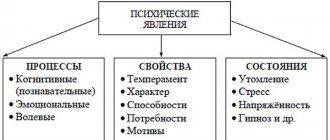Man is a social creature and constantly interacts with other people throughout his life. Without communication, life and activities of any society together are impossible. The concept of communication means the establishment and development of relationships between people and groups, the creation of interpersonal contacts in the process of joint life activities. Scientists have established what functions communication performs.
Business conversation
Communication from the perspective of psychology
The term “communication” refers to different forms of interaction between people, which are carried out using various sign means, such as:
- facial expressions;
- symbols;
- images.
The desire to contact another person arises from the need to act together.
Significance in psychology
To clearly understand what communication is, it is necessary to consider the various definitions of the term. They will help to form a multifaceted understanding of this method of communication:
- Human communication is considered in psychology to be a complex and multifaceted process that is aimed at establishing and developing contacts between a group of people.
- According to the literature on the culture of communications, communication is a unique process of exchanging the results of spiritual and mental activity between people. This may include assessments, thoughts, feelings, judgments, attitudes.
- Communication is also a basic psychological need of a person, which contributes to the formation of personality. In the process of interpersonal contacts, the subjective world of one individual opens up to another. This allows a person to self-determinate and self-present himself in society.
List of used literature.
- Bekhterev V.M. Selected works on social psychology. M., 1997.
- Bodalev A.A. Personality and communication. M., 2005.
- Zeldovich B.Z. Business conversation. M., 2007.
- Leontyev A.A. Psychology of communication. M., 2002.
- Parygin B.D. Social Psychology. St. Petersburg, 1999.
- Psychology of influence: Reader. St. Petersburg, 2000.
Attention!
If you need help writing a paper, we recommend turning to professionals. More than 70,000 authors are ready to help you right now. Free adjustments and improvements. Find out the cost of your work
Free estimate
+7
Size: 29.14K
Downloads: 57
05/03/11 at 14:46 Author:MeLaMory
Liked? Click on the button below. It's not difficult for you
, and we
are pleased
).
To download test papers for free at maximum speed, register or log in to the site.
Important! All submitted Tests for free downloading are intended for drawing up a plan or basis for your own scientific works.
Friends! You have a unique opportunity to help students just like you! If our site helped you find the job you need, then you certainly understand how the job you add can make the work of others easier.
Add a job
If the Test work, in your opinion, is of poor quality, or you have already seen this work, please let us know.
The essence of communication, purpose, functions
Verbal communication - what is it in psychology
Sociologists believe that interpersonal communication is an excellent way to convey social experience and culture to other people. Domestic psychologists support the idea that the purpose of communication is to create unity between the exchange of information and activities in society. But it is unrealistic to make an exchange if there is no understanding between people, because it helps to achieve success and establish close contact.
Important! Therefore, understanding is the main goal of interpersonal contacts. The result of communications depends on it.
Communication goals
Communication in a person’s life performs 8 main functions.
Contact
To understand what the contact function means and why it is needed, it is enough to remember the main fear of a person - the fear of being misunderstood.
Important! This barrier prevents the establishment of close and long-term relationships with people.
The more one person communicates with another, the easier it is to establish contact between them and, as a result, understanding.
Information
The information function is responsible for the generation, transmission and reception of information. It is implemented in several stages:
- first, differences in the awareness of individuals who are aimed at entering into psychological contact are equalized;
- then beliefs, thoughts, facts are transmitted, and conclusions are drawn about what was heard;
- at the third stage, the desire to understand the interlocutor is formed.
This function of communication is important because messages, plans, decisions and opinions help to establish understanding between contacting entities.
Incentive
The incentive function allows you to stimulate a person to take active action. In this case, communication allows you to manage people.
Additional Information. In the modern world, this function is used in all areas of activity for manipulation.
Commercials are a prime example of successful implementation of a feature.
Coordination
The coordination function allows people to engage in joint activities. Thanks to it, a group of people can coordinate their actions and effectively complete the task. If the function is implemented poorly, such communication will bring disappointment and losses.
Emotive
Thanks to the emotive function, people are able to arouse the necessary emotional experiences in their partner, as well as change their own state.
Important! The transfer of emotions can occur both verbally and non-verbally.
If the methods of emotional regulation between partners are different, then the effective implementation of this function in communication will be impossible, and people will encounter misunderstandings and conflicts.
Understanding function
The terminology of the word “understanding” is associated with such concepts as “meaning” and “meaning”. Based on this, the main task of this function is to explain to the two people in contact the purpose of their communication, as well as the further development of events. Understanding also allows partners to get to know each other and predict the behavior, attitudes and state of the interlocutor in the future.
Influence function
The influence function is similar to the incentive function. Its main goal is to change the behavior, state, personal and semantic formations of the interlocutor.
Important! To implement the function, a variety of psychosocial influence techniques can be used. It can be used for both positive and negative purposes.
Ratio function
The relationship management function allows an individual to realize and fix his place in business, status, and interpersonal relationships. With its help, a person has his own circle of interests, important and necessary people, as well as acquaintances for specific matters.
Causes of cognitive impairment
To help a person treat cognitive problems, you need to know what caused this illness, because the result depends on the correct diagnosis. Cognitive impairment can develop at any age with various somatic, mental and neurological diseases. Among the main reasons are:
- Alzheimer's disease;
- vascular diseases of the brain (cerebral ischemia, cerebral infarction);
- Parkinson's disease;
- a brain tumor;
- traumatic brain injury;
- demyelinating diseases and neuroinfections (HIV, multiple sclerosis, Creutzfeldt-Jakob disease, progressive panencephalitis);
- overwork, negative emotions and depression;
- dysmetabolic encephalopathies (domestic and industrial intoxication, deficiency of proteins, B vitamins and folic acid, renal and liver failure, iatrogenic cognitive impairment).
If a person has chronic degenerative and vascular diseases of the brain, then it is almost impossible to overcome cognitive impairment. In any other case, timely correction will help correct the situation. The duo of cognitive functioning and medications can be used to achieve this.
Additional Information. Cognitive functioning is a set of activities that will help “activate” and improve cognitive functions.
This includes the following list of simple activities:
- learning foreign languages;
- development of new routes and territories;
- playing musical instruments;
- development of positive thinking;
- yoga, dancing or strength training.
Iatrogenic disorders
Often, cognitive impairment is directly related to taking a large amount of medications and their side effects.
What is iatrogeny
Important! About 5% of dementias develop due to iatrogenic causes.
The following medications have an adverse effect on cognitive function:
- neuroleptics;
- diuretics;
- antidepressants;
- products with bromine;
- opiates;
- cosmetics with bismuth;
- antifungal antibiotics;
- drugs against tumors;
- sedatives.
Also, the development of iatrogenic disorders can occur due to radiation therapy, which is carried out in the fight against malignant tumors in the body. Any drugs that have an effect on neuronal function or overall homeostasis should be primarily considered as a major cause of cognitive impairment.
To protect yourself and your loved ones from a decline in memory, thinking, attention and other abilities, you need to eat right, walk more in the fresh air, train cognitive skills, engage in active sports and not take any medications without first consulting a specialist.
Types of communication
Nonverbal communication - what is it in psychology
The exchange of information between people can be extremely diverse. A communicative classification will help you understand what communication is, what its role is in society, and what types it comes in.
Types of communication
By content
When communication is built between people, defining its goals is the main task at the very beginning. Therefore, dividing communication by content makes it possible to establish the motives for contact. According to this classification, communication occurs:
- Activity. There is an exchange of skills, abilities, operations and actions between individuals.
- Motivational. With such communication, people exchange needs, interests, and motivations.
- Air-conditioned. Thanks to this type, one person is able to make an exchange of physiological and mental states.
- Cognitive. The main purpose of such communication is to transfer knowledge.
- Material. When communicating, people exchange products and objects.
By purpose
According to goals, communication is divided into 2 types:
- social, in which the goal is to expand and strengthen interpersonal contacts;
- biological, which is required by society for the support and development of the organism.
Via communication channel
According to the communication channel, communication is divided into the following types:
- Non-verbal. The exchange of information between people is carried out using gestures and facial expressions.
- Verbal. This channel of social communication is realized through speech.
- Artificial. Communication is carried out through unique amulets, tattoos, and symbols that have a certain meaning. This type also includes books, the press, telephones, television and radio broadcasting.
Affordable
By means of communication there are:
- Indirect. Communication is carried out with the help of intermediaries.
- Direct. Conversations between people take place in personal contact.
- Indirect. In this communication, various means and tools are used to exchange information between people. Social networks are a prime example of such communication.
- Direct. Communication occurs through natural organs, such as vision and hearing.
By contact
Depending on the contact with the interlocutor, communication can be:
- Indirect. This type of communication is considered indirect. Exchange between people occurs when they are distant from each other. For example, this is correspondence, telephone conversation.
- Direct. It is direct communication in which subjects are close to each other and exchange information using facial expressions, gestures and speech. This type is considered the most complete, since in the process individuals are able to gain maximum knowledge about each other.
According to the conditions of the situation
Depending on the situation, communication occurs:
- Official. Official communication is carried out exclusively in the business sphere. It is characterized by the presence of a large number of formalities and rules.
- Unofficial. Private communication is not limited to a set of rules. It can happen in any area.
Similar works
- Psychology of communication: the role of perception in the communication process
- Psychology of communication: concept, types, definition
- Psychology of communication: types and functions of communication
- Psychology of communication: types, concept of communication
- Psychology of communication: definition, types and functions
- Psychology of communication (communication functions and test)
- Psychology of communication
- Psychology of communication: perception in the process of communication
- Psychology of communication: disclosure of the concept, types and functions of communication
- Psychology of communication: concept, types and functions
- Psychology of communication: concept, errors of perception
- Psychology of communication (Option No. 10)
- Psychology of communication: functions of communication, errors in perception
- Psychology of communication: concept, types and function of communication
- Psychology of communication
- Psychology of communication: types and functions, error of perception
Features of communication
Functions of communication in psychology and their brief description
After the term “communication” has become clear, what it is and what it is needed for, it’s time to study its features. They will help you build proper communication:
- For quality communication, the presence of two active individuals is necessary.
- During a conversation, it is necessary to have mutual influence on each other, both emotional and physiological.
- Partners must have a single or similar information exchange system.
- When communicating, there must be room for communication barriers to arise.
Basic Rules
In addition to these norms, there are social rules that can improve communication between people.
Tests.
Correlate the proposed socio-psychological concepts and their definitions:
a) stereotype;
b) prejudice;
1) one-sided, distorted and, as a rule, prejudiced view, characteristic of representatives of professional, age, social, ethnic groups or classes;
2) personal antipathy or active hostility towards another social group; however, individuals may or may not participate in discriminatory activities based on their views.
Answer: a-2, b-1.
1) Stereotype - personal antipathy and active hostility towards another social group; however, individuals may or may not participate in discriminatory activities based on their views.
2) Prejudice is a one-sided, distorted and, as a rule, prejudiced view characteristic of representatives of professional, age, social, ethnic groups or classes.
Rules of communication (communication)
To prevent interpersonal relationships with friends, colleagues or a loved one from deteriorating over time, you need to learn the basic rules of communication:
- To create a trusting and informative conversation, visual contact is necessary.
- It is advisable to speak only to the point. Expressions that do not carry any semantic meaning should be excluded from the vocabulary.
- The conversation must always be maintained by asking questions and clarifying information.
- To keep the conversation going, you need to answer in detail. It is better to exclude monosyllabic and simple answers when speaking.
- You should not use words unknown to the interlocutor. The language and reasoning must be understandable to both.
- A good mood is the key to an interesting conversation. Even a business meeting could use a little humor and smiles.
- There should be no things in your hands during a conversation. They can take the interlocutor's attention to themselves.
- Pauses during conversation are insidious enemies. Long silence (more than 10 seconds) will cause discomfort.
Communication between a person and another individual is an art that anyone can master if they follow the above recommendations.
How to communicate with impossible people
Difficult people require a special approach during conversation. If you need to contact an unpleasant person, you can minimize the receipt of negative emotions using 5 basic rules:
- You should not take your opponent’s criticism or advice that you haven’t asked for personally.
- If your interlocutor likes to interrupt, you should not allow him to do so. This requires politely explaining to the person that his arguments will not be heard until the speech is finished.
- If the interlocutor does not want to talk, but you need to get an answer from him, in this case the best communication is to briefly state the essence of the question.
- We should not forget about the ability to listen to your opponent. Thanks to an attentive attitude towards the interlocutor, respect for his words and thoughts will be visible.
- There is no need to teach a person to communicate if he does it somehow wrong. Each individual has his own way of speaking. Therefore, an evaluative conversation will only irritate.
Communication is the key to the whole world. Careful study of the operating instructions and proper use will make it easier to achieve your goals.











